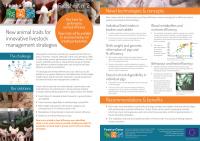Factsheet N°2 New animal traits for innovative livestock management strategies
 The challenge
The challenge
Monogastric production animals are usually kept and fed as a group. However, animals, although of the same genotype, differ in feed intake, growth performance and feed efficiency. For this reason, individual animals or characterized groups of animals have different nutrient requirements and should be fed diets differing in nutrient composition.
The background of these differences is not clear but can be related to e.g. genetic differences and differences in birth weight, health status, and the animal’s response to social interactions, and environmental and management conditions.
Our solutions
Feed-a-Gene explored new traits related to performance and feed efficiency for potential use in future precision feeding concepts and breeding programmes in pigs, broilers and rabbits:
- Feed intake of individual animals housed in a group (broilers and rabbits)
- Faecal nutrient digestibility in individual pigs using NIRS
- Birth weight and genomic information of piglets and consequences on N-efficiency later in life
- Metabolites in blood related to feed and nutrient efficiency
- Behaviour and feed efficiency in pigs
New traits related to feed efficiency were identified, which can be used in future precision feeding concepts for production animals kept in groups and in future breeding strategies.